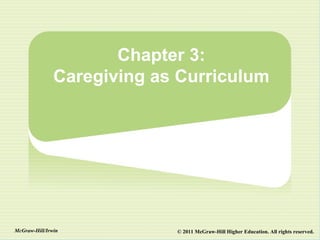
Infants, Toddlers & Caregivers Ch 3
- 1. Chapter 3: Caregiving as Curriculum McGraw-Hill/Irwin © 2011 McGraw-Hill Higher Education. All rights reserved.
- 2. Thinking Again About Infant-Toddler Curriculum • Infant-toddler curriculum is a relationship-based approach that: – Stresses everyday activities such as feeding and diapering – Takes an activity approach that focuses on caregiving routines – Turns daily routines into curriculum 3-2
- 3. Thinking Again About Infant-Toddler Curriculum • Planning for attachment—a tie to a special person—is a part of curriculum. • Through three-R relationships, children develop attachment, which gives them: – A sense of trust and security – A sense of importance – The knowledge that they are being cared about as well as cared for 3-3
- 4. Policies that Support Curriculum as Caregiving • Three policies for a caregiving curriculum: – A primary caregiving system – Consistency – Continuity of care 3-4
- 5. Policies that Support Curriculum as Caregiving • A primary caregiving system: – Assigns each caregiver to a small number of children – Promotes attachment by building relationship – Provides for interactions between caregivers and all children in the setting, not just the caregiver’s assigned children What are some potential concerns with this system? 3-5
- 6. Policies that Support Curriculum as Caregiving • Consistency – If caregivers plan carefully for change, children feel more secure when it comes. – Consistency gives children a sense of security. – Predictability is an important part of consistency. 3-6
- 7. Policies that Support Curriculum as Caregiving • Continuity of care – Continuity of care means children stay with one caregiver for several years. – A program which values continuity of care finds ways to keep the group together. – Continuity of care promotes attachment to adults and other children. 3-7
- 8. Assessment • Assessing needs depends on communication. • Attachment helps you learn each child’s way of communicating. What are some reasons why infants cry? 3-8
- 9. Caregiving Routines • Caregiving routines include: – Feeding – Diapering – Toilet training and toilet learning – Washing, bathing, and grooming – Dressing – Napping 3-9
- 10. Caregiving Routines • Feeding – Release time allows caregivers to hold each baby while feeding. – Feeding time should be quality time. – Not all cultures view feeding similarly. Remember to communicate with family members about feeding. 3-10
- 11. Caregiving Routines • Feeding – Caregivers can help children learn self-help skills by: • Using child-sized utensils • Providing finger foods • Giving small amounts of food • Allowing children to explore and experiment with food 3-11
- 12. Caregiving Routines • Feeding – Pay close attention to food preparation, storage, and clean up. – Introduce foods one at a time. What foods should be avoided during the first 6 months? During toddlerhood? Why? 3-12
- 13. Caregiving Routines • Diapering – Diapering is not a time for distraction. – Involve children fully in the task. • Acknowledge their feelings • Verbalize their experiences – Know proper sanitation procedures and follow them at all times. 3-13
- 14. Caregiving Routines • Toilet Training and Toilet Learning – Toilet learning is a readiness-based approach. – Toilet learning depends on cooperation between caregivers and family members, with a respect for cultural influences. – Consistency is a vital part of toilet learning. 3-14
- 15. Caregiving Routines • Washing, Bathing, and Grooming – Most programs leave bathing up to parents. – Hand washing is a great time for children to learn: • A self-help skill • The sensory properties of soap and water • How to prepare themselves for eating – Remember to respect various beliefs about grooming. 3-15
- 16. Caregiving Routines • Dressing – Dressing activities allow children to develop: • Self-help skills • Motor coordination • Cooperative skills with caregivers How does dressing develop motor coordination? 3-16
- 17. Caregiving Routines • Napping – Infants should be allowed to rest according to their individual needs. – Caregivers should learn each child’s ways of expressing the need to rest. – Each infant or toddler should have a personal crib/nap space. 3-17
- 18. Caregiving Routines • Napping – Caregivers need to know how to reduce the risk of SIDS. – Hints to help toddlers sleep include: • Removing visual distractions when necessary • Providing a quiet, peaceful atmosphere • Ensuring all children get plenty of fresh air and exercise • Not allowing children to get overtired 3-18
- 19. Caregiving as Curriculum • Caregiving as curriculum helps children learn: – Cooperation – Self-help skills – Predictability – Attachment – Communication – And so much more! 3-19
- 20. Online Learning Center • See Chapter 3 of the text’s Online Learning Center for chapter quizzes, Theory Into Action activities, Video Observations, and more. 3-20
